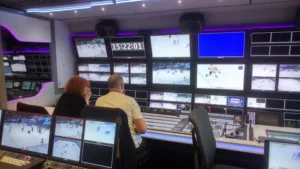In my preview of IFA a couple of months ago, I said that I expected to see quite a lot of high refresh rate (HFR) technology. However there was little to see at IFA, although more at IBC. Why was that?

Last year at IFA, LG showed a demonstration of 100Hz OLED technology that had been developed with the EBU and that showed how much better sports broadcasting could be with higher frame rates. However, although this was widely reported as being UltraHD, the resolution was actually only 2560 x 1440 with 100fps, as the drivers for the OLED TVs simply couldn’t run fast enough for 2160p. And that brings us to one of the problems of HFR – the need to support very high bit rates.
Although, on the face of it, you might assume that doubling the frame rate means doubling the amount of data being needed, in fact, if you are compressing the data, you only need around 20% extra bandwidth because the changes between one frame and the next are smaller if you have more frames in the same time. Of course, broadcasters don’t like to provide extra bandwidth but as I reported last year in an article on “better pixels”, research in Europe has shown that, at a given bit rate, consumers prefer more compression and a higher frame rate rather than fewer frames and less compression, so there’s an argument that broadcasters might not have to provide more bandwidth. (More, Better, Faster!)
4Ever captured an ice hockey match in HFR earlier this year. Image:4Ever
Furthermore, tests by Ericsson and by the EBU, in the past, have shown that HFR and lower resolution is often better received by viewers than higher spatial resolution and fewer frames. Public broadcasters, especially in Europe, are more interested in delivering 1080P with 60 or more frames, than sending UHD resolution. Europeans still like smaller TV sets than are popular in many other parts of the world and many viewers will not get any benefit from higher spatial resolution because of this. However, they will see the benefit of higher refresh. In addition, terrestrial broadcasting of higher frame rate 1080P is much more practical than going up to higher resolutions and terrestrial delivery remains important in many countries of Europe for public broadcasters.
The Pay & Public Broadcasters Align
Unusually, the interests of the public and pay TV providers have come into alignment here. The big driver of pay TV, again especially in Europe, is live sports and that definitely looks better in high frame rates, especially popular sports such as football, hockey (very clear advantages were shown at IFA) and even cricket. Going up to higher frame rates also makes life harder for those that want to supply content over broadband, and that means that there is a good incentive for satellite operators to get behind the technology with their PayTV customers. Sky was happy to support the idea of HFR when we spoke to them at the shows.
Unfortunately, there are two points when there is little or no compression and that is during production and at the display side when you are driving the panel and no compression means problems. In the production side, programme makers are struggling already with the bitrates for 3840 x 2160 and HDR. Although technology such as light compression is helping to squeeze more bits through the existing SDI pipes that broadcasters have, adding HFR and HDR on top makes things very tricky.
 LG showed HFR at the SES Industry Day
LG showed HFR at the SES Industry Day
At the display end, panel controller makers are also struggling to cope and we hear that memory bandwidths are struggling to meet the needs of displays. A panel of 3840 x 2160 x 30 bits x 100Hz is around 25Gbps so that means a lot of data going into and out of the display controller chips. Further, the obvious beneficiary of faster frame rates is OLED and that means LG, of course. Unfortunately, the need to compensate the performance of OLED panel at the pixel level makes things very tricky.
As frame rates go up and bit depths go up as well as resolution, the amount of data that you need to transmit to the panel goes up, while the time available goes down. That’s a double whammy and one of the reasons that we heard recently that LG can show HDR and UHD resolution on its OLEDs at the moment, and can also show HFR and UHD resolution, but can’t show HDR and HFR and UHD resolution at the same time. (Which is, I suspect, why 100Hz was not so prominent this time). LG did show 100Hz with 3840 x 2160 at the SES open day in May (LG and SES Show UHD High Frame Rate Technology – subscription required)
Do Set Makers and Broadcasters Align?
The advantages of, and need for HFR increase as spatial resolution goes up, so it looks as though 8K may settle on 100Hz, but from the European and US broadcasters’ points of view, 8K is some time away. (although, as I suggested a few weeks ago, panel makers may have a different agenda- 8K is Closer than You Think)
So, unlike the race to higher spatial resolutions, where the set makers, enabled by the LCD makers, have been in the vanguard, the move to HFR may depend on the broadcasters rather than the set makers. It might, of course, be dependent on an alliance between the broadcasters and the set makers – and that would be a novelty in recent history! – Bob Raikes

